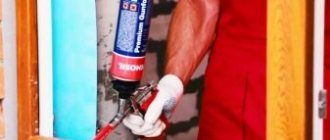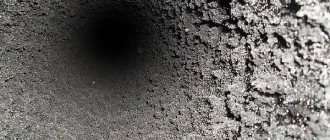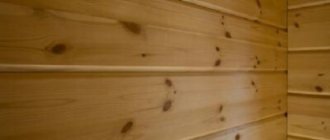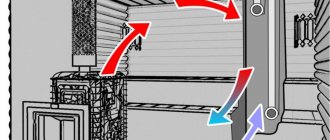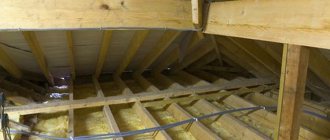Good day, dear amateur builders!
Are you planning a renovation? Do you need to seal joints, cracks and crevices? Don't know which tool to use? Friends, polyurethane foam will do this job flawlessly.
Don't have a construction gun? You can buy a relatively inexpensive tool at any specialty store. Did you spend a lot of money on renovations? No opportunity to purchase “weapons”? Understood.
In this case, here is the topic of the article - polyurethane foam without a gun: how to use this “construction gadget” without having some experience? Let's look at this in more detail.
Polyurethane foam sealant: a little theory
How to work with sealant without a foam gun? Very simple. But first, let's talk a little about the main character of this article - foam. For what? And then, to understand the principle of operation of polyurethane foam. I think no one wants to ruin the substance and the home. It is so? Great. Then let's get started.
Story
The sealant was born thanks to the German chemist-technologist Otto Bayer. He invented the substance back in 1937. Or rather, he discovered polyurethane. And in 1970, specialists from an English company invented polyurethane foam sealant.
It has been tested and improved over the years. In 1980 it was used by construction workers in Sweden. The invention was to the liking of many maestros of architectural art, since it had a number of positive properties.
Today, of course, sealant is produced in many countries. For its production, exclusively innovative technologies are used.
Concept
Polyurethane foam or polyurethane foam sealant is a substance that consists of two components - polyols and methyl...ate (you'll break your tongue there). In addition, in the manufacturing process of the product, stabilizers, catalysts, a mixture of butane and propane, etc. are used.
Subtleties of application
In order for the quality of work to be excellent, you need to study the intricacies of applying polyurethane foam.
Before the application process, the working conditions recommended by the material manufacturer should be created. Temperature 5–20 degrees. No work is carried out at temperatures above 30 degrees. For low temperatures, frost-resistant products are used.
During operation, the location and longitude of use are taken into account. This determines which cylinder to buy: household or professional. The household one has a special tube through which the mixture is supplied to hard-to-reach places and does not require the use of a gun. With such cylinders, quick repairs are carried out. Professional is designed for a pistol. It is served in precise portions and used over and over again.
Correctly foaming with polyurethane foam means taking into account the following: filling too quickly will lead to the formation of air pockets in which there is no density. If filling is very slow, excess consumption of mass occurs. Since the required amount falls into the cracks and necessary spaces, and some protrudes out.
For better adhesion, the surface to be treated must be thoroughly cleaned of all contaminants and moistened. It is moisture that will affect the even distribution of the material and the adhesion strength.
Moisturizing should be moderate. For this it is better to use a spray bottle.
To reduce the consumption of carbon dioxide when distributing the composition, the cylinder is held upside down. You also need to maintain a tilt angle of 45 degrees. Maintaining such subtleties when applying the mass will reduce its consumption and increase adhesion.
Specifications
Pena is a lady with excellent technical characteristics, for which she has gained an army of fans. So, the characteristics of polyurethane foam are as follows:
- shrinkage – 5%;
- porosity – 88%;
- output volume – 300 ml can – 20 l of foam, 500 ml – 40 l, 750 ml – 50 l, 1000 ml – 80 l;
- polymerization speed - 20 minutes - gain of useful volume, 4 hours - hardening, 24 hours - complete hardening;
- adhesion – excellent adhesion to wood, concrete, glass, metal, PVC, stone, poor adhesion to silicone and polyethylene;
- heat resistance - -45/+90°С;
- strength – 3–5 N/cm2.
Always buy extra foam. Manufacturers often deceive consumers. So, for example, they write “50 liters” on the cylinder, but in reality it is much less, well, somewhere around 25–30 liters. I think everyone understands why cunning manufacturers do this - a common marketing ploy. Therefore, play it safe.
Disadvantages and advantages of household construction foam
The following can be noted:
- increased material consumption due to the impossibility of accurately dosing its output;
- difficulties during work: the cylinder has to be held upside down, by the girth, which puts stress on the arms and leads to fatigue;
- the cost is usually cheaper compared to professional;
- satisfactory work result .
Thus, if there is no mounting gun available, then there is nothing left but to use mounting foam with a tube. The video process of the work can be viewed on numerous sites on the Internet dedicated to construction. .
One of the most popular materials that have excellent insulating properties, composition and ease of use is polyurethane foam. Using polyurethane foam is convenient, so beginners in this business can easily cope with the task assigned to them.
Application area
The sealant has eclipsed many of its predecessors - plaster, mineral wool tapes, cement, bitumen, etc., which is no wonder.
It is used for:
- installation of door and window blocks;
- fastening insulation, waterproofing, sound insulation;
- filling cracks and crevices formed during repairs;
- filling voids that appeared during construction;
- performing facing works;
- filling holes, cracks, cracks in interior items.
The substance has a wide range of applications. Because of this, it will definitely not be forgotten, somewhere on a dusty shelf in the garage or closet.
Foam a small gap
The standard diameter of the gun tube allows you to foam seams up to 5 cm at a time. If you need to foam a larger seam, this is done in several passes. But what to do if the seam is very small for a standard tube?
I do not recommend using narrow tubes for this. The longer the narrow tube, the more difficult it is to control foaming, as spitting appears. It is better to make a narrower end at the end of a thicker tube. To do this, you can use a narrowed tip of the pen, or the same heat-shrink tube, which can easily be made narrower at the end.
Classification
In order not to feel like a “blonde” while “shopping”, you should study the varieties of the substance.
Release:
- professional (for a pistol);
- household (with a tube nozzle).
Compound:
- two-component;
- one-component.
Flammability:
- B1 – off;
- B2 – lights up, but goes out;
- B3 – lit.
Season:
- winter – used at outside temperatures of -20/+35°C;
- summer – used at +5–35°С;
- winter-spring-summer-autumn – used at -10/+35°C.
Usage:
- reusable – reusable;
- disposable – used once (the remainder is thrown away).
So, we’ve sorted out the types of the main character of the article.
Which one is better? Well, to each his own. For example, for large volumes, specialists use professional two-component polyurethane foam, which is distinguished by its all-season, non-flammable and reusable properties. For those interested, here is an article about sprayed thermal insulation. But we, as non-professionals, can use a household option with flammability class B1, intended for one-time use.
Life hack: how to do without a foam gun
If you don’t have a mounting gun on hand, or it breaks down during work, you can use improvised methods. We invite you to pay attention to a simple alternative to the tool. To do this you will need a wire braid. To use it, we take out the core. After this, we will need a dowel of a suitable diameter, cut it to the cut. After this, it becomes shortened and convenient to use. We put the dowel on the end of the braid. As a result, the slot on the dowel will disappear. Otherwise, foam will leak out during use. If you can’t put it on tightly, trim the dowel a little more.
The dowel fits perfectly due to its tight fit. We tear off the lid of the cylinder, attach the dowel and gradually begin to press. The polyurethane foam begins to come out of the container. When working with such a homemade device, be sure to use protective gloves.
VIDEO: How to use foam without a gun
Polyurethane foam sealant: a little practice
So, we have learned a lot about polyurethane foam sealant. It's time to figure out how to use it without a gun.
Step-by-step instruction
I’ll be honest: it’s difficult to work with foam without a gun, but it’s possible, since the household version has a special tube. So, let's start operation "X".
The process consists of the following steps:
- gloves are put on (the best option);
- the surface for work is prepared: it is cleaned of dirt and dust;
- if necessary (if the gaps are too wide or deep) they are sealed with pieces of foam plastic or its analogues;
- shake the container (1 minute) so that the foam has a uniform consistency and intensive release from the container;
- Using an ordinary household sprayer, lightly moisten the foaming area with water - (liquid should not flow or drip);
- remove the cap from the cylinder;
- put a special tube, which comes with the kit, onto the protrusion valve;
- the edge of the tube is brought to the area that needs to be filled with foam, and the valve is pressed (the seam being processed is half filled);
- important point: the working position of the cylinder is bottom up;
- after 30 minutes, the treated area is checked, if there are any “jambs” left, foam is added;
- after a day (but it can be done much earlier), the frozen excess polyurethane foam is cut off with a sharp stationery knife;
- finishing work must be carried out, since the foam is “afraid” of ultraviolet radiation (sunlight) - this is plaster, painting or other cladding.
Difficult? Difficult? No. There is absolutely nothing to be afraid of, but there is no need to relax either...
How to use polyurethane foam correctly?
When choosing polyurethane foam, you should pay attention to the following important points:
- Best before date. If it is coming to an end, it is better not to use the consumable, since after the expiration date it will not perform its functions.
- Be sure to shake off the container before use. Time - at least half a minute.
- After this, we turn the cylinder over and get to work. This is important because propylene gas is always lighter than foam, and it is responsible for pushing the foam out of the cylinder. It's at the top.
- Even sealants with excellent adhesion require surface preparation. Remove dust and lightly moisten the surface. Avoid large amounts of water as it will prevent sticking.
- After applying the foam, you can further moisten it. This will speed up polymerization. This is easy to explain: polyurethane takes moisture from the air to expand and harden. If we moisten the sealant, we can speed up this process.
- After complete hardening, excess foam must be cut off with a sharp knife.
- If you need to foam the cracks of hard-to-reach places, it is better to consider an elongated tube. The cylinder should be on top.
- If the tube is not suitable for filling a very narrow gap, its diameter can be reduced in several ways. You can light the tube and carefully pull it out. We do this carefully so as not to deform it. The second option is heat shrink tubing. Heat shrink will also help if the tube is lost. In this case, we take a tube of suitable diameter, screw it onto the cylinder, heat it, put on the washer and use it.
- If you need to fill large-diameter gaps, you need to perform the work in several stages. Apply the first layer, wait for it to harden, then apply the second layer. And so on until we fill the entire hole.
- If you do not press on the balloon or set it aside, the remaining foam continues to expand. This may cause it to harden.
Foams come in professional grades with a gun thread and household foams with a tube. The main differences between the cylinders:
- Purpose. Household polyurethane foam without a gun is mainly used for 1-2 times, industrial foam with proper use and storage for a longer period.
- Application. For professional models, we additionally buy a pistol or make it from improvised materials.
- Volumes. Depending on the required amount of building material, buy cylinders from 300 ml to several liters.
Servicing the foam can after work
Of course, if the work was carried out without a gun, the can of foam is thrown away, since the sealant hardens in the tube and valve after use. Reuse is not possible. But I have one folk secret in my bins, which tells about how to keep the valve mechanism operational and ready for combat.
The secret is quite simple: in order for the polyurethane foam to be reused, you just need to block the air access to the valve mechanism. How to do it? I'll tell you now.
It is necessary to insert a foreign object-plug into the tube filled with foam, which will prevent air from entering it. After sealing, the container should be placed in a dark and cool place.
If there is a need for foam, it is enough to cut off part of the tube in the place where the installed plug is located. For example, I never wash my pistol, and it has always been ready and loaded for five years now. Thus, even household foam can be reused many times.
In addition, the cylinder should be kept clean. If foam gets on it, you need to wipe the container using a solvent, avoiding getting the plastic elements wet. By the way, you should not carry out sealing and insulation work in the rain and snow - it is fraught with poor quality workmanship.
Reusing a can without a gun
The possibility of reusing the cylinder cannot be ruled out. To do this, you need to carefully bend the tube and then secure the bend using tape or tape. To maintain pressure in the tube, press the valve.
If more than 5 months have passed since the first use of the cylinder, you cannot do without using acetone. Once the tube is removed from the valve, it should be thoroughly rinsed with acetone. It would also be a good idea to flush the valve with the same acetone. It is recommended to perform this simple procedure 2-3 times.
Recommendations for using low expansion foam
Polyurethane foam with a low coefficient of expansion is used for cracks up to ten centimeters. The expansion coefficient indicates how much the distributed volume of mass will change from the original.
Basic recommendations for use:
- If the gap is one centimeter wide, then sealants without secondary expansion must be used.
- If you need to fill cracks of more than 10 cm with such a composition, then it is advisable to use compactors to reduce the space and reduce the likelihood of the mass draining under its own weight.
- For better adhesion, the planes are moistened, and after distributing the mixture and initial drying, the seam is treated with water from a sprayer.
- Poor adhesion to silicone, polyethylene, Teflon, and uncleaned surfaces.
- Mixing of the mass occurs when the container is held upside down. Shaking is required before each use.
- If the cylinder was at a low temperature, then before use it must be warmed up to 20 degrees.
- It is not allowed to touch the foam before it dries, as this will disrupt the polymerization process.
- The composition is available in light shades. If it has changed during storage, then this composition is unsuitable for use.
